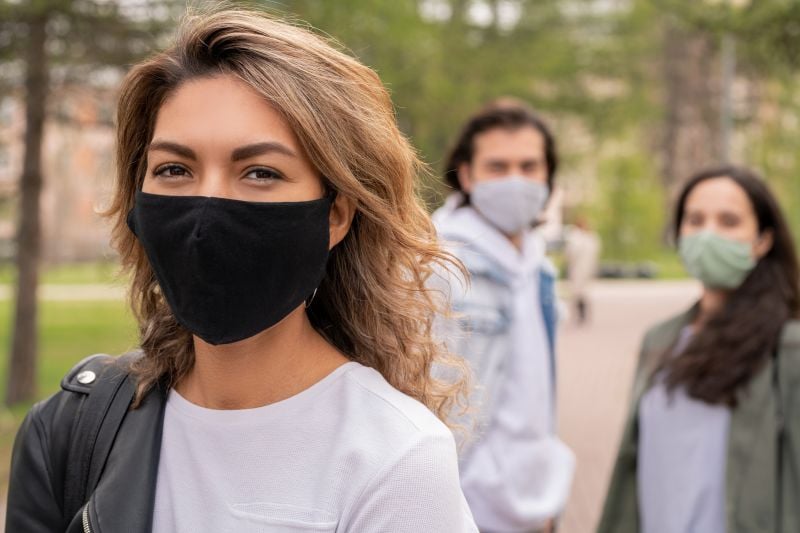We cover the following topics in this article:
- Introduction to Contact Tracing
- What is the Johns Hopkins University Contact Tracing course like?
- Why Take the COVID-19 Contact Tracing Course?
- What is COVID-19?
- Understanding How Coronavirus Spreads
- Understanding the Timeline of Infection and the Infectious Period
- What is Contact Tracing?
- What Does a Contact Tracer Do?
- Skills and Knowledge Contact Tracers Need
- How COVID-19 Contact Tracing Technology Can Help
- Dovetail Check, Track and Trace
- Conclusion
Introduction to Contact Tracing
Contact tracing is being hailed as one of the best ways to ensure coronavirus doesn’t spread as countries come out of lockdown.
We wanted to find out more about how contact tracing works, as we were confident we could apply its methodology in creating new health screening and contact tracing features within Dovetail, that would help HR teams, their organizations and employees safely get back to work.
So several of us Dovetailers, enrolled on the Johns Hopkins University Contact Tracing course, run in conjunction with the online training platform Coursera and became certified contact tracers.
The course, which over 430,000 people have already taken, consists of a series of video lectures, multiple choice practice questions and ends with a 40 question exam. It is an introductory contact tracing course, where students learn about the science of SARS-CoV-2 (the clinical term for the virus that causes COVID-19), its infectious period, and how COVID-19 is transmitted from person-to-person. We also learned why contact tracing is such an effective public health intervention. The course has been very well received with a 4.9 rating from 30,000 reviews so far.
We highly recommend you taking the course, not only if you are involved in Contact Tracing at your work, but also as it is invaluable training education on the current pandemic, which is affecting us all.
Other key lessons, which we cover in detail in this guide, include:
- how to carry out contact tracing using an easy-to-follow 6 step process
- how to identify and support people who have contracted the disease and those they have been in contact with, in order to stop the transmission of the virus in their communities
- how to build rapport with people who have contracted the disease
- how to identify some of the most common barriers to contact tracing efforts - along with strategies to overcome them
- how important ethical, privacy and confidentiality matters that relate to contact tracing, isolation, and quarantine are in the contact tracing process
The course is led by Dr. Emily S. Gurley, Associate Scientist, Department of Epidemiology at Johns Hopkins Bloomberg School of Public Health who has worked in public health research for over 15 years.
We have been able to apply the knowledge gained on the course to the development of new health screening and contact tracing features, which we've named Dovetail Check, Track and Trace.
Dovetail Check, Track and Trace helps organizations protect their employees when they return to onsite work locations. It is also the perfect solution for Universities and their students, as students return to campus.
What follows is an overview of the course, including the benefits of taking it, and Dovetail’s new health screening and contact tracing capabilities, Dovetail Check, Track and Trace.
What is the Johns Hopkins University Contact Tracing course like?
It took me an intense seven hours to complete the course, but Coursera has a feature that allows you to watch the videos at a faster speed setting, which can accelerate the learning process substantially.
At the end of the course, I had to take a 40 question exam. The pass mark is 85%, and you only have two attempts to pass, otherwise you have to wait 2 days until you can take it again. So I was happy to pass the first time with a mark of 95%!
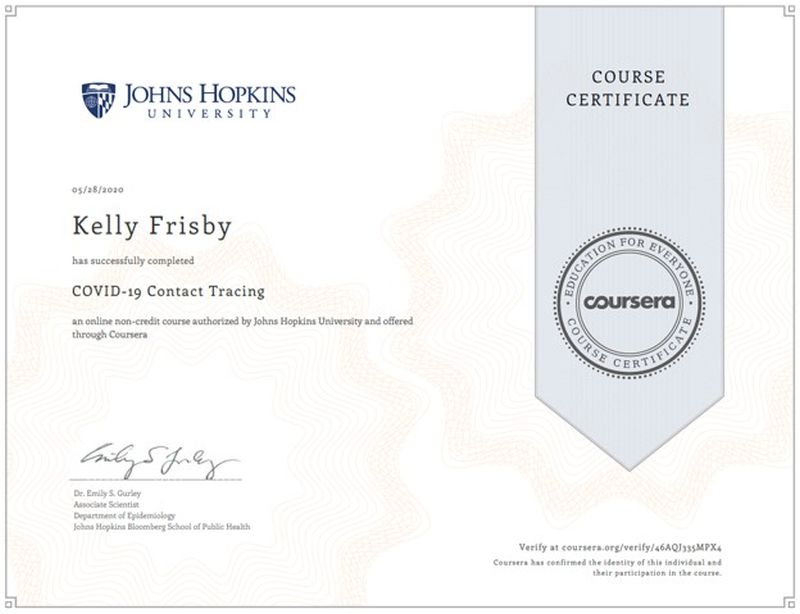
Why Take the COVID-19 Contact Tracing Course?
Many countries are taking contact tracing seriously as it is seen as a way of reducing the spread of coronavirus, particularly as lockdown restrictions are eased. For example, the UK government has recruited 25,000 contact tracers to be at the heart of its new test, track and trace strategy, and stated that contact tracing technology will play a key role in supporting them.
Ultimately, contact tracing is crucial to stopping the spread of the virus in our communities. As SHRM (Society for Human Resource Management) states in a recent article entitled Contact Tracing for Employers: How to handle investigations and notifications if a worker has COVID-19:
“After learning that one or more employees have been diagnosed with COVID-19, companies should act quickly to identify and notify any co-workers who might have been exposed during the infectious period.”
The Center for Disease Control and Prevention (CDC) also offer advice and resources to help businesses and the wider community limit the spread of COVID-19:
- Contact Tracing: Get and Keep America Open: Supporting states, tribes, localities, and territories - contains COVID-19 FAQs, Training, Digital Tools and other helpful resources
- A spreadsheet-based contact tracing tool called COVIDTracer
What is COVID-19?
You’d think we’d all know by now the answer to this question. However, it’s worth a quick refresh.
COVID-19, officially called SARS-CoV-2, is a new virus that originated in bats, which has jumped species and can be transmitted among people. COVID-19 is the third coronavirus to have done so since 2002:
- Severe Acute Respiratory Syndrome (SARS) CoV emerged in Guangdon, China, in 2002
- Middle Eastern Respiratory Syndrome (MERS) CoV emerged in the Middle East in 2012
- And finally, SARS-CoV-2 emerged in Wuhan, China, in 2019
This reminds us that virus pandemics are not a one-off. Indeed, Deutsche Bank Research stated that after COVID-19, the possibility of a new global influenza pandemic is one of four potential catastrophes that has a 33% chance of occurring within the next decade.
Being ‘pandemic-ready’ and future-proofing this capability, is becoming a necessity for businesses everywhere, and this requires knowledge about how the disease spreads in order to take action to reduce its risks to your business.
Back to top
One way to measure how COVID-19 spreads, is to observe the R number, or reproductive number, of the disease.
The R number is a way of rating a disease's ability to spread. It's the number of people that one infected person will pass the virus on to, on average. For example, measles has one of the highest R numbers, with a reproductive number of 15 in populations without immunity, which means it can cause explosive outbreaks. Other diseases such as ebola and seasonal influenza have R numbers of 1.5 to 2, and 1.27 respectively.
The slide below illustrates the rapid spread of a virus with an R number equal to 2.
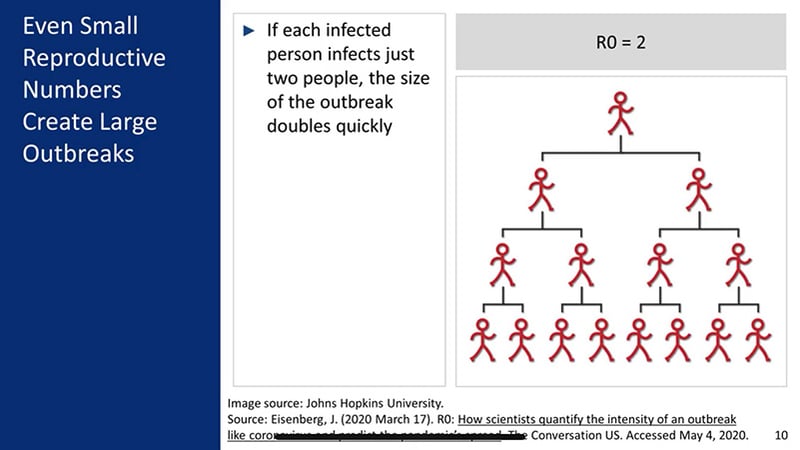
The next slide below shows what happens if we stop each case from infecting just one person:
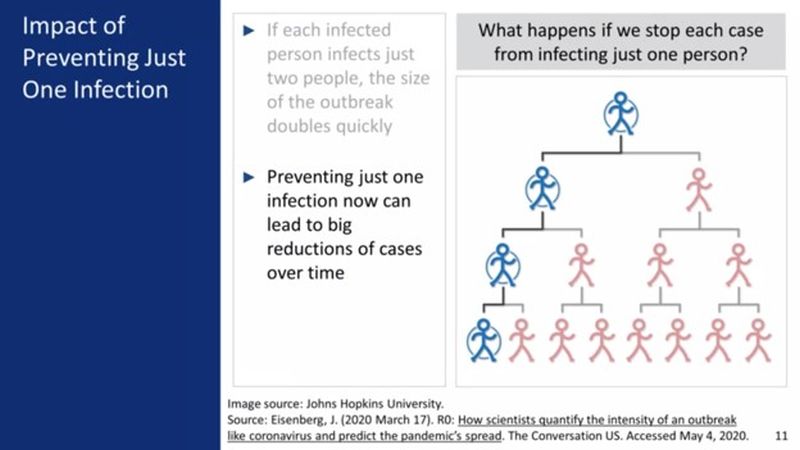
COVID-19 has a reproduction number of about 3, which means it can spread rapidly if measures are not put in place to limit its transmission.
To do this, it’s necessary to understand the Timeline of Infection and determine the ‘window of opportunity’: the period during which a Contact Tracer can get in touch with an infected person, and ask them to go into quarantine.
Understanding the Timeline of Infection and the Infectious Period
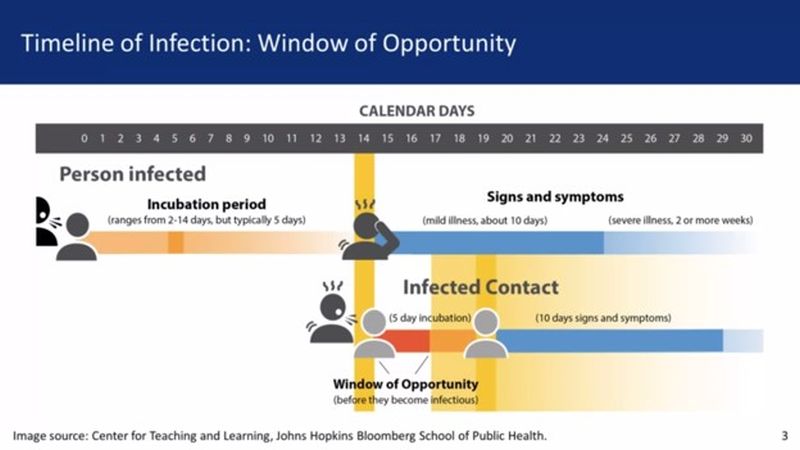
The infectious period is the time during which someone infected with COVID-19 can transmit the virus to other people. It begins 2 days before the start of signs and symptoms of the disease. According to Johns Hopkins university, the end of the infectious period is at least 10 days after the onset of the illness AND symptoms are improving AND there has been no fever within the last 3 days.
Note that people who are asymptomatic can also be infectious. For these people, the infectious period is more difficult to define.
On average, 50% of cases will have symptoms after 5 days. For these cases, there is a 3 day period, the ‘window of opportunity’, when contact tracers can make contact with the infected person, and ask them to self quarantine for 14 days, before they risk infecting another person.
The slide below defines the infectious period:
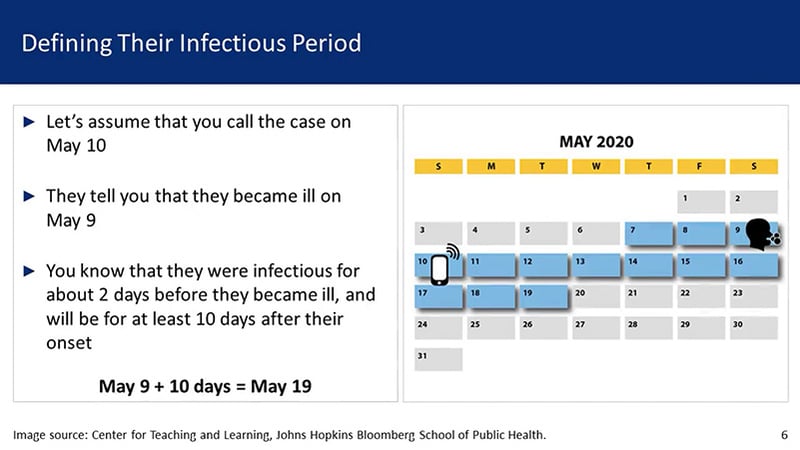
Note that transmission is more likely with close, or physical contact: within 6 feet for 15 minutes or more, sharing the same environment (for example, offices and restaurants), or sharing food, bathrooms, or beds.
Let’s now look at what Contact Tracing is and how it works.
What is Contact Tracing?
Contact Tracing is a holistic solution to investigating, tracing and preventing the spread of infectious diseases. At its best, it involves integrating the expertise and capabilities of human Contact Tracers, with effective communication skills and knowledge in contact tracing techniques, ethics, privacy and confidentiality matters, with the latest in advanced contact tracing technology.
By merging the human traits of empathy and compassion with the efficiency that technology offers, a Contact Tracing solution is considered one of the best ways to stop the spread of the coronavirus.
The following are standard terms in contact tracing:
Case and Contact Definitions
A “case” is a person who has contracted COVID-19 and is still contagious.
A “contact” is someone who has been in contact with a case, and therefore has potentially contracted the disease.
Isolation and Quarantine
Isolation means a case (a person infected with COVID-19) should try to eliminate contact with other people for the duration of the infectious period, which is 2 days before the onset of symptoms and at least 10 days afterwards. The exception to this is if the case needs to see a doctor. If the case lives with others, they might try and find a different place to stay. Or they may isolate in their own bedroom and bathroom. It means wearing a mask if there is any reason to be around other people.
Quarantine separates and restricts the movement of people who were exposed to a contagious disease for 14 days, to see if they become sick.
The slide below shows the 14 day period a person should stay in quarantine after being in contact with a case.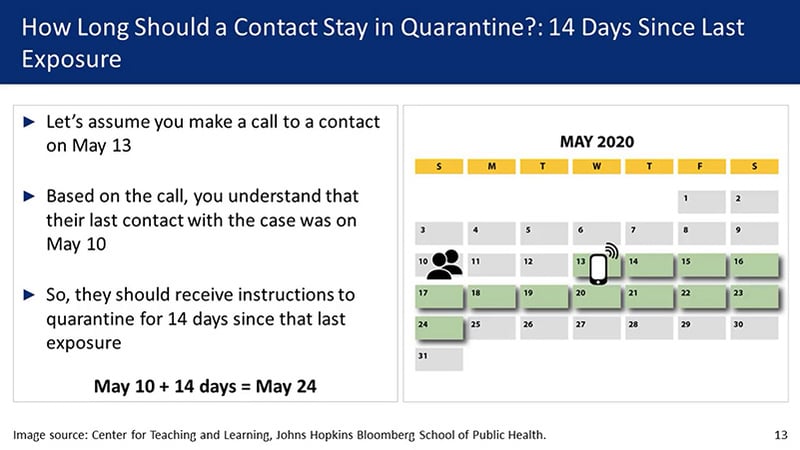
Incubation period
The incubation period is the time from when someone is infected until symptoms develop. The COVID-19 incubation period ranges from 2 to 14 days, however, 50% of people (who are symptomatic) will have symptoms by 5 days after they are infected
Asymptomatic
Some people who are infected have no symptoms and are therefore asymptomatic
What Does a Contact Tracer Do?
A COVID-19 contact tracer calls up people known to be infected with coronavirus and works out whom they have met, and where they have been in recent days. They can then track down those people the case has been in contact with, and ask them to go into quarantine.
There are 6 Steps Contact Tracers follow when investigating a case and tracing their contacts. The slide below details the process:
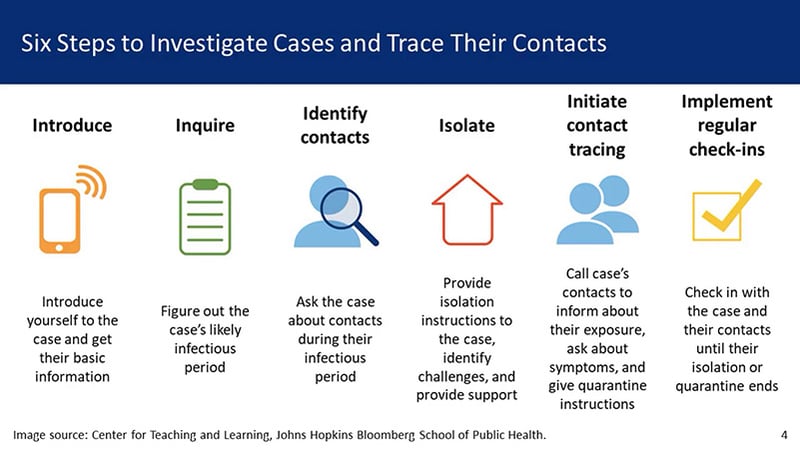
These 6 steps fit together in three parts: 1) Calling the case, 2) Calling the contact, and 3) Implementing regular check-ins with the case and contact:
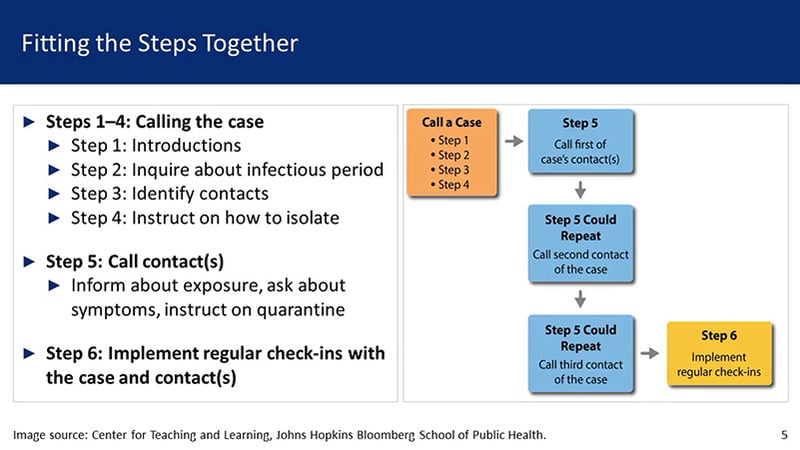
Skills and Knowledge Contact Tracers Need
There are a number of skills Contact Tracers need to have in order to be effective at contact tracing. These include:
- Communication skills - For contact tracers, being able to communicate effectively with cases and contacts is key to a successful outcome. The ability to build rapport with people over the phone, use different questions types (for example open versus closed, and probing and checking questions), and be an active listener are all important. The goal is to connect with people, be empathetic and use a compassionate tone, but also to be assertive, in order to ensure the tracing procedure is carried out effectively. Below is an example (from the Johns Hopkins course) of an assertive answer to a common question asked by people infected with coronavirus was given:
Coronavirus case*: “Why should I stay at home or tell you who I’ve seen recently?”
Contact Tracer: “You’d like to know why I’m asking you to stay at home. Well, by staying separated, you’re helping your loved ones and the community stay safe. We strongly recommend that you - and lots of other people like you - stay at home so we can stop the spread of the virus.”
*Source: Johns Hopkins University Coursera Course
- Ethics, Privacy, and Confidentiality - We learned that contact tracing has been used to reduce the risk of infectious diseases to the public for a over century, and that contact tracers need to be sensitive to the balance between individual rights and those of the public. Being attentive to the issues of privacy and confidentiality are fundamental to tracing within ethical and legal boundaries.
- Privacy is the right of a person to be free from intrusion or publicity concerning personal matters.
- Confidentiality is defined as the right of an individual to have personal, identifiable medical information kept private, and not released without their consent. However, a person’s COVID-19 test results can be shared to protect public health.
Combining these skills with technology, Contact Tracers can speed up the contact tracing process and significantly reduce the spread of the virus in our communities.
How COVID-19 Contact Tracing Technology Can Help
According to Johns Hopkins University, the use of technology in contact tracing improves the efficiency and speed of the contact tracing process. This is because:
- contact tracers need to reach people quickly, before they have infected another person
- public health staff time is often limited. As it takes time for Contact Tracers to gather data and information on cases, technology that automates and standardizes reporting of tests to Contact Tracers, speeds up the contact tracing process. This means less time is spent between diagnosis and a call from the Contact Tracer.
- patient data can be accessed from a centralized database. When patients get a test for COVID-19, their information is entered into an electronic system with a centralized database where positive test results are reported from the lab.
As a technology company with software that already has many capabilities that Contact Tracers need, we were keen to see how we could use our expertise to develop a Contact Tracing solution.
The result are the new Dovetail Check, Track and Trace features. Let’s find out more about how they work.
Dovetail Check, Track and Trace
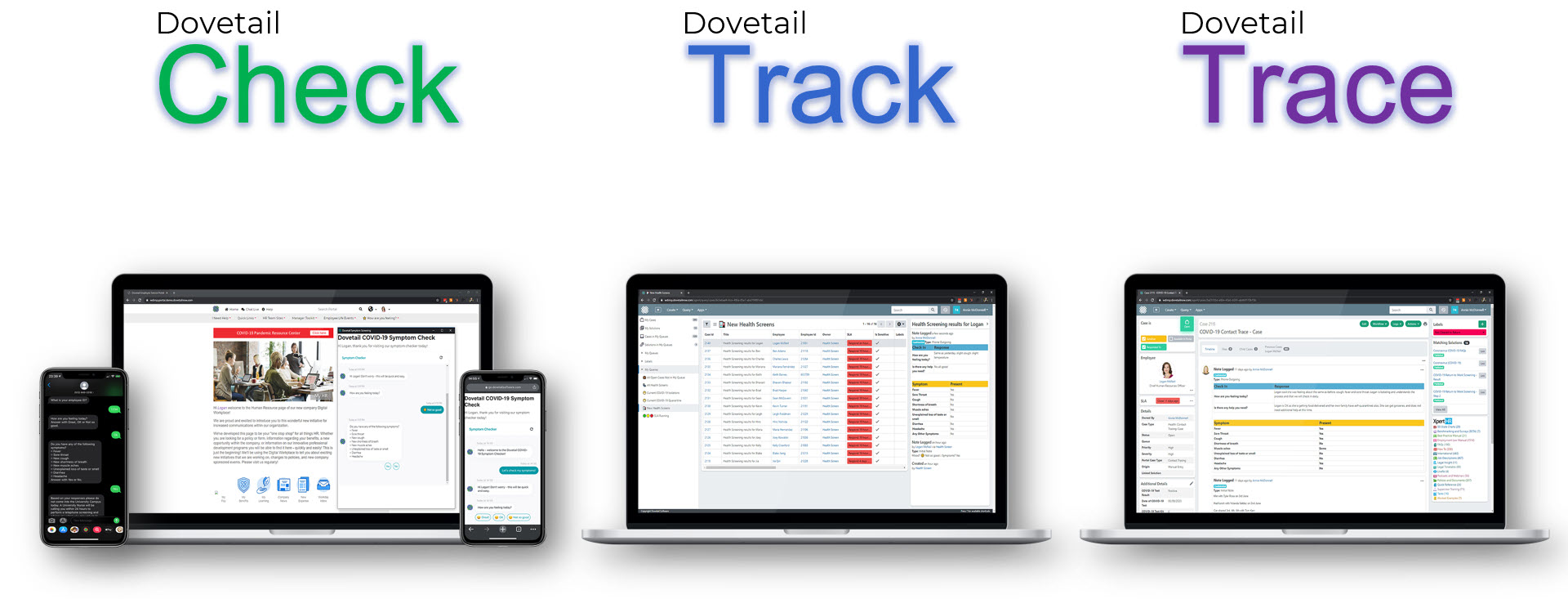
Dovetail Check, Track and Trace for Desktop & Mobile
We have developed the Dovetail Check, Track and Trace features to support HR teams, Health workers, and Contact Tracers when carrying out health screenings and contact tracing. There are three key features:
- Dovetail Check allows you to check symptoms of your employees on a daily basis and comply with state and local laws for screening employees.
By checking and screening your employees for symptoms of coronavirus on a daily basis, via a Check-in process, you can identify who may have contracted the virus, and should go into isolation in order to stop them from spreading the virus to others. Those who, based on a symptom check, are unlikely to have COVID-19, are then free to come into the office.
Those employees who are suspected of having COVID-19, and have been requested to go into isolation, can then receive a COVID-19 test kit to determine whether they test positive for coronavirus, which can all be tracked through Dovetail.
Dovetail Check is available on browser, mobile SMS and mobile browser.
- Dovetail Track allows you to monitor and keep track of all health screens that have taken place, and follow up with those individuals who have symptoms of COVID-19.
- Dovetail Trace is a contact tracing feature that enables you to monitor and trace employees that are confirmed positive with COVID-19. It also allows you to trace back to all the other employees that an infected person has been in contact with during their infectious period. You can then contact and ask them to self quarantine, and track any symptoms they may have over the 14 day quarantine period. Dovetail Trace also supports automatic updates, notifications and Service Level Agreements.
Click the video link below to find out more about the Dovetail Check, Track and Trace features:
Conclusion
The COVID-19 crisis has created an unprecedented need for effective health screening and contact tracing solutions in countries that are trying to stop the spread of the virus and get back to work.
Putting a Health Screening & Contact Tracing solution in place can help your organization limit the spread of the virus among employees, which not only makes them feel safer in the workplace, but also ensures your company can continue to operate effectively during the pandemic. The NEW Dovetail Check, Track and Trace features, built for desktop and mobile phones, and with features that enable health screenings for all your employees, as well as allowing the tracking and tracing of COVID-19 cases and their contacts, will help your organization achieve these aims.
By adopting the NEW Dovetail Check, Track and Trace features as part of your health screening and contact tracing strategy, your organization will be better able to safeguard employees as they return to the workplace.
Click here to find out more about Dovetail Check, Track and Trace


























